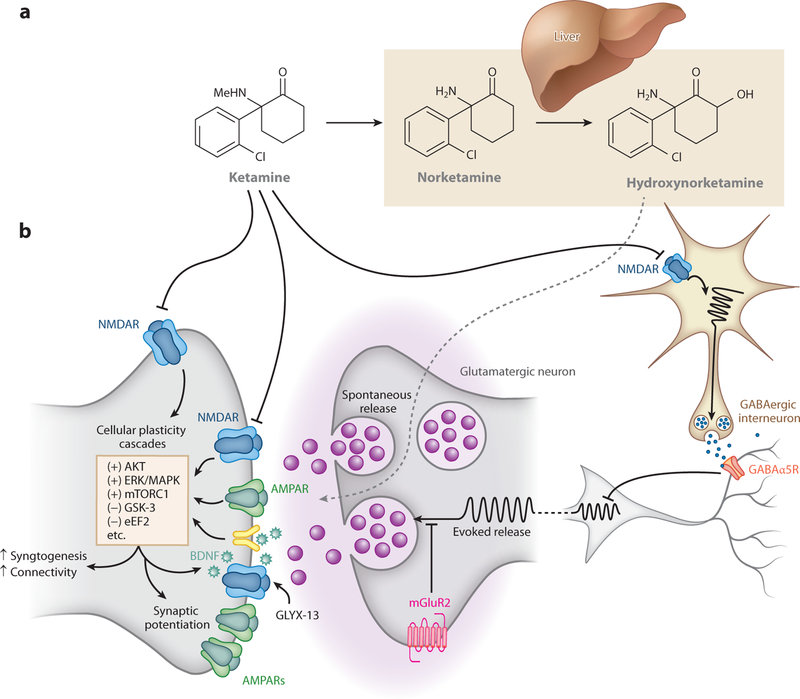Figure 1.

Pharmacology of rapid-acting antidepressants in corticomesolimbic brain circuits. Preclinical data suggest that ketamine and other rapid-acting antidepressants potentiate excitatory synapses in mood-relevant brain regions, potentially reversing disease-induced deficits. New treatments may potentiate these connections while leaving synapses primarily involved in other brain functions unaltered. (a) The principle ketamine metabolic pathway occurs in the liver, resulting first in demethylation of ketamine to norketamine, followed by metabolism to the HNKs. The most prominent HNK metabolites are (2R,6R)- and (2S,6S)-HNK. (b) Rapid-acting antidepressants potentiate glutamatergic synapses. Ketamine, acting as an NMDAR antagonist, may act by preferentially blocking NMDARs localized to GABAergic interneurons, resulting in disinhibition of glutamatergic neurons and an increase in these neurons’ evoked release of glutamate. Ketamine may also act by inhibiting synaptic NMDARs that are activated by spontaneously released glutamate or via inhibition of extrasynaptic NMDARs. Alternatively (or in addition), ketamine conversion to (2R,6R; 2S,6S)-HNK may result in actions on glutamatergic neurons to promote glutamate release and AMPA receptor (AMPAR)-mediated excitation. All hypotheses converge on synaptic processes that strengthen excitatory synapses, activate cellular plasticity cascades, increase activity of AMPARs, and increase connectivity within circuits previously weakened by the pathophysiology underlying depression. Alternative approaches that may have the same net effect include inhibition of GABAα5Rs, resulting in disinhibition of glutamatergic neurons; inhibition of muscarinic acetylcholine receptors (not shown), resulting in inhibition of GABAergic neurons and disinhibition of glutamatergic neurons; inhibition of mGluR2s, resulting in increased probability of glutamate release; and direct activation of synaptic AMPARs and NMDARs (via AMPAkines or NMDAR modulators such as GLYX-13). Abbreviations: AKT, protein kinase B; AMPAR, α-amino-3-hydroxy-5-methyl-4-isoxazolepropionic acid receptor; BDNF, brain-derived neurotrophic factor; eEF2, eukaryotic elongation factor 2; ERK/MAPK, extracellular signal-regulated kinase/mitogen-activated kinase; GABAα5R, γ-aminobutyric acid α 5 receptor; GLYX-13, glyxins 13; GSK-3, glycogen synthase kinase-3; HNK, hydroxynorketamine; mGluR2, metabotropic glutamate receptor 2; NMDAR, N-methyl-D-aspartate receptor; mTORC1, mechanistic target of rapamycin complex 1.
